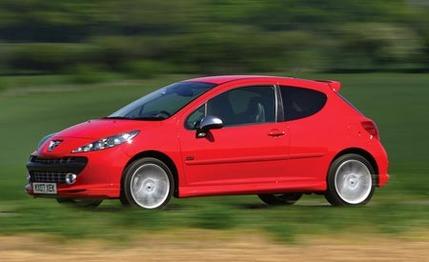
 First Drive Review
First Drive Review
It has been 14 years since Peugeot pulled out of the American market. In the U.S., the French carmaker mostly sold conservative 405 and 505 sedans and wagons. Okay, the 505 Turbo and the 405Mi16 were gutsy, but aside from those niche entries, the brand was almost a Gallic Volvo, minus the reliability. In Europe in the intervening years, Peugeot has taken on a younger, more stylish image. After remarkable sales growth through the 1990s, the brand, when coupled with partner Citroën, now ranks second in European sales.
The car that started Peugeot on its current path was the 205GTi. This little hatchback was introduced in 1984 (never sold in America) and followed the successful formula of the Volkswagen GTI-lightweight, inexpensive, economical, and quick. It soon became an object of desire for British enthusiasts. It is the nature of things that small cars get bigger with every new generation. Although it sold well, the successor to the 205, the 206, lost some of the 205's go-kart appeal, and the 207, introduced last year, seemed to have thrown away its heritage. It was less rewarding to drive and offered an uninspiring range of engines, concentrating on economical diesels. Also, there was no GTi version of the new car.
Now there is a GTi-called the 207GTi in England, but known as the 207RC in France-and it revives much of the spirit of that first GTi, albeit in a larger and more comfortable package. The irony is that the closest current car to the 1980s 205GTi, in size and sportiness, is the Mini Cooper S, a car that shares its turbocharged engine with the 207GTi. The 172-hp, 1.6-liter turbocharged direct-injection four-cylinder engine was a joint venture between Peugeot and Mini's owner, BMW. Much of the engine's design came from BMW, but most of the castings and other components are made by Peugeot, and each company assembles the engines for its own vehicles. As in the Cooper S, the engine allows for a brief spike in boost from 11.8 psi to 14.7 psi, which increases torque from 177 pound-feet to 192. That momentary rise in boost pressure allows a five-speed manual 207GTi (there's no six-speed manual) to dispatch 60 mph in about seven seconds-a few ticks slower than the lighter six-speed Cooper S.
Compared with the latest Mini Cooper S, the Peugeot 207 offers more refinement and interior room. But the 207 is also 12.4 inches longer, nearly three inches wider, and about 200 pounds heavier. The turbo mill is quieter in the 207, but it retains smoothness and progressive power delivery; it's difficult to detect any turbo lag.
The Peugeot is a quick car on a winding road, but it lacks the sharp reactions of the old 205 or even some of the more recent European competitors like the Renault Clio 197 or Opel Corsa OPC. The GTi's suspension is much tauter than the base 207's-the torsion beam at the rear is 50 percent stiffer-and that keeps body motions in check, but it makes for a nervous ride over bumpy roads. Furthermore, the electric power steering lacks the tactile feel and meatiness that hot hatches should have. For those who have less talent than fear, stability control is standard.
Enveloping Recaro seats, charcoal-colored Alcantara trim, and all the latest safety equipment, including six airbags, put this GTi into a different class than its spartan ancestors. Like the people who bought and enjoyed the first-generation 205GTi-and I was one of them-the GTi has grown up.